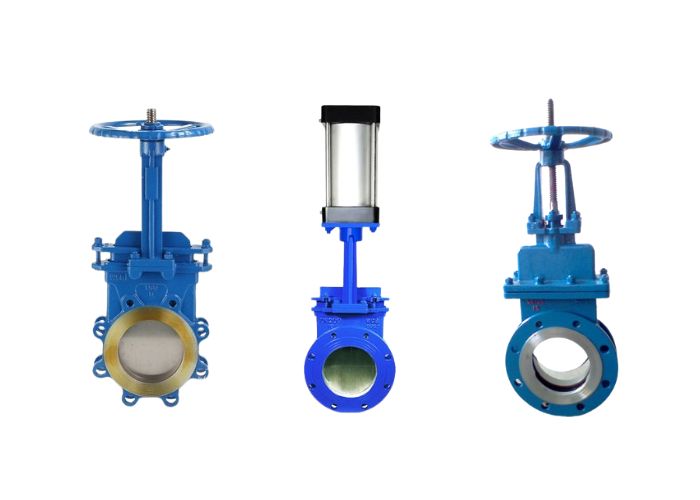
Knife gate valves are critical components in many industrial processes that require dependable and efficient flow control. These valves have distinct characteristics and capabilities that make them ideal for specific applications. Understanding when to use a knife gate valve is critical for achieving peak performance and minimizing operational issues.
In this article, we’ll look at the applications where knife gate valves shine and discuss the elements that influence their applicability. We will also look at the benefits and drawbacks of these valves, as well as their operational mechanisms and maintenance requirements.
This blog will give you the knowledge to make informed decisions about implementing knife gate valves into your systems, whether you work in mining, chemical processing, wastewater treatment, or another industry. Let’s explore the world of knife gate valves and learn about their importance in industrial flow control.
Understanding Knife Gate Valves
A knife gate valve is a linear motion valve designed to control the flow of fluids containing solid particles, such as slurries or powders. It consists of several essential components:
1. Body: The main housing contains the flow passage and supports the other valve components.
2. Gate: The gate is a flat or beveled plate that moves perpendicular to the flow direction. It acts as a closure element, sealing off or allowing fluid flow.
3. Seat: The seat provides a sealing surface against which the gate closes. It helps prevent leakage when the valve is in the closed position.
4. Stem: The stem connects the gate to the actuator or handwheel, allowing for the opening and closing of the valve.
5. Actuator: The actuator is responsible for operating the valve. It can be manual (handwheel or lever) or automated (electric, pneumatic, or hydraulic).
A linear motion mechanism controls knife gate valves. When the valve is in the closed position, the gate seals against the seat, preventing fluid flow. When you open the valve, the gate retracts into the body, allowing fluid to flow through the open flow route.
Flow control in knife gate valves is accomplished by moving the gate. The gate can be partially opened to control the flow rate or closed to stop it. When the valve is closed, the gate and seat are designed to achieve a tight shut-off, minimizing leakage.
Key Advantages of Knife Gate Valve
§ Suitable for handling abrasive media.
§ Compact design.
§ Bi-directional flow capability.
§ Easy maintenance.
Limitations of Knife Gate Valve
§ Limited application in clean fluid services
§ Reduced throttling capabilities
§ Potential for gate jamming
Applications of Knife Gate Valves
Mining and Mineral Processing Industries
§ Slurry Handling and Thickening Applications: Knife gate valves are widely employed in mining operations to control abrasive slurries’ flow with solid particles. They excel in applications such as ore transportation, grinding circuits, and flotation cells, where precise flow control and reliable shut-off are necessary to manage slurries effectively and prevent leakage and wear.
§ Tailings and Waste Water Management: Knife gate valves play a vital role in mining operations for tailings and wastewater management. They are used in tailings management systems to control slurry discharge into containment areas. Additionally, these valves are employed in mining wastewater treatment plants to regulate effluent flow, sludge, and other waste streams, ensuring efficient and controlled handling of these materials.
Pulp and Paper Industries
§ Fibrous and High-Consistency Slurry Handling: Knife gate valves are critical for handling fibrous slurries in the pulp and paper industries. They excel in controlling the flow of high-consistency slurry with a high concentration of fibers. These valves use extensively in processes like pulp refining, stock preparation, and paper machine headbox control, ensuring accurate and dependable flow regulation.
§ Liquor Control in Digesters and Bleaching Processes: Knife gate valves are utilized in the pulp and paper manufacturing process to regulate the flow of liquor, which includes chemicals and solvents, into critical stages such as digesters and bleaching processes. These valves offer reliable shut-off capabilities, preventing leakage and ensuring process efficiency. They find application in various areas, including black liquor handling, white liquor handling, and chemical recovery systems within the pulp and paper industry.
Chemical and Petrochemical Industries
§ Abrasive and Corrosive Fluid Handling: Knife gate valves are well-suited for handling abrasive and corrosive fluids in chemical and petrochemical processes. They are designed to withstand the erosive and corrosive nature of the fluids encountered in these industries. These valves find typical applications in handling slurries, acids, alkalis, and other aggressive chemicals, providing reliable flow control while minimizing the risks of valve wear and leakage.
§ Sludge and Effluent Control: Knife gate valves are crucial in chemical and petrochemical plants for controlling the flow of sludge and effluent in treatment systems. They play a vital role in ensuring environmental compliance by providing effective shut-off capabilities, preventing the backflow of contaminants, and maintaining the integrity of treatment processes. These valves contribute to the efficient and reliable management of sludge and effluent in these industries.
Water and Wastewater Treatment Plants
§ Sludge Handling and Dewatering: Knife gate valves are extensively used in water and wastewater treatment plants for sludge handling and dewatering processes. These valves are instrumental in controlling sludge flow during the thickening, dewatering, and disposal stages. They provide reliable shut-off to prevent sludge backflow and ensure efficient dewatering operations, thereby contributing to the overall effectiveness of the treatment plant.
§ Grit and Solids Removal: Knife gate valves are utilized in water and wastewater treatment plants to regulate the flow of water containing grit and solids. They play a critical role in facilitating the separation and removal of grit and solids in grit chambers or sedimentation tanks. These valves offer robust construction and tight shut-off capabilities, preventing the passage of grit and solids into downstream processes and safeguarding pumps and equipment from potential damage.

Factors to Consider When Selecting a Knife Gate Valve
Choosing the suitable knife gate valve for a specific application requires careful consideration of several vital factors. These factors include:
1. Fluid Characteristics and Conditions:
– The fluid’s viscosity, temperature, and pressure.
– Abrasiveness and chemical compatibility with valve materials.
2. Pipe Size and Pressure Rating:
– Ensure the valve size matches the pipe size for proper installation.
– Consider the pressure rating to ensure the valve can handle the required operating pressures.
3. Valve Design and Material Selection:
– Select the appropriate valve design based on the application requirements, such as rising or non-rising stem, wafer or lug design, etc.
– Choose valve materials that can withstand the fluid properties and resist corrosion, erosion, and wear. Common materials include stainless steel, cast iron, and various coatings.
4. Actuation Options and Automation Requirements:
– Determine the type of actuation needed, such as manual handwheel, lever, or automated options like electric, pneumatic, or hydraulic actuators.
– Consider the level of automation required for process integration, remote control, or feedback monitoring.
5. Industry Standards and Certifications:
– Ensure the valve meets industry standards and certifications relevant to the application, such as ANSI, API, ISO, or NSF standards.
6. Maintenance and Serviceability:
– Evaluate the ease of maintenance, availability of spare parts, and the reputation of the manufacturer or supplier in terms of after-sales support.
Alternative Valve Options and Their Suitability
A. Ball Valves vs. Knife Gate Valves:
Ball Valves:
§ Suitable for clean fluid applications with low concentrations of solids.
§ Offer quick and easy quarter-turn operation for flow control.
§ Provide reliable shut-off and high-pressure capabilities.
§ Ideal for applications requiring precise throttling.
Knife Gate Valves:
§ Suitable for handling abrasive slurries and high-consistency fluids with solid particles.
§ Offer bi-directional flow control and robust construction.
§ Effective in applications where solids and debris may cause issues with ball valves.
§ Provide tight shut-off and resistance to wear and corrosion.
Suitability: Ball valves are more appropriate for clean fluid services, while knife gate valves excel in abrasive slurries and solids handling applications.
B. Gate Valves vs. Knife Gate Valves:
Gate Valves:
§ Commonly used in applications requiring a linear, on-off flow control.
§ Suitable for a wide range of clean fluid and gas services.
§ Provide low-pressure drop and tight shut-off capabilities.
§ Typically used in systems where frequent operation is not required.
Knife Gate Valves:
§ Specifically designed for handling slurries and fluids with solids.
§ Offer efficient flow control and resistance to abrasive wear.
§ Well-suited for applications with high concentrations of solids and debris.
§ Provide reliable shut-off and bi-directional flow capabilities.
Suitability: Gate valves are more suitable for clean fluid and gas services, while knife gate valves are designed explicitly for abrasive slurries and solids handling applications.
C. Butterfly Valves vs. Knife Gate Valves:
Butterfly Valves:
§ Commonly used in low-pressure applications with clean fluids.
§ Offer compact design, cost-effectiveness, and ease of installation.
§ Provide quick quarter-turn operation and good throttling capabilities.
§ Suitable for systems with limited space and moderate flow control requirements.
Knife Gate Valves:
§ Designed for applications involving slurries and high-consistency fluids.
§ Provide reliable shut-off and resistance to abrasive wear.
§ Well-suited for systems with high concentrations of solids and debris.
§ Effective in processes where tight shut-off and bi-directional flow control are necessary.
Suitability: Butterfly valves are more suitable for low-pressure, clean fluid applications, while knife gate valves are designed explicitly for slurries and fluids with solids.
Conclusion
In conclusion, when faced with applications involving abrasive slurries, high-consistency fluids, and solids handling knife gate valves emerge as a reliable and effective solution. Industries can ensure efficient flow control, minimize downtime, and enhance overall productivity by selecting the correct knife gate valve and considering alternative options when appropriate.






